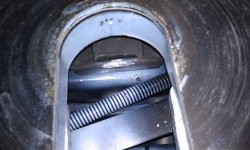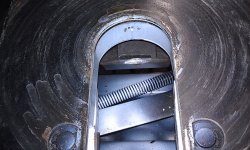Just noticed this badly worn area of inside the front of my reese 16K fitth wheel hitch. Looks like the front of the pin, is wearing into the hitch. I use of those nylon wear plates between the truck and the pin box. So this pin shoudnt be touching this far down in the hitch, I guess. The front and botton if the pin is also worn. Any thoughts?
Abnormal Wear inside hitch
- Thread starter sengli
- Start date
Pizzadigger
Active Member
I don't know about those hitches , maybe adjustment or some thing bent . How about using two nylon hitch plates?
Andy
Andy
Garypowell
Well-known member
While my guess is it is not dangerous something is not right. I am sure Reese would be interested to see the pictures but I would also measure the pin so they can tell you if it is in spec.
westxsrt10
Perfict Senior Member
EDIT:
(I see what why you have issues now).
(I see what why you have issues now).
Last edited:
Talked to the dealer today, he says what I most likely what I did was have the pin box too high when I hitched up last time. I must have gone over the top of the front stop, in the hitch, and then dropped the pin on it. He thought I might have bent the front stop piece, but it doesn't look bent. It did put and ever so small radius on the front, bottom lip of of the pin too.
Does everyone use one of those nylon discs to prevent wear between the pin box, and the hitch plate?
Does everyone use one of those nylon discs to prevent wear between the pin box, and the hitch plate?
Jon
I used to do that same routine as well. But my hitch head used to have some "tension" to it, it would stay where you put it, till something contacted it. Now it is so loose that it wont stay "up" in order for me to ride the pin box on to it. Side to side, and front to back it is loose. I have to use some foam blocks to hold it " up" to get the sight line I need to hitch up these days. Has anyone elses loosened this much?
I used to do that same routine as well. But my hitch head used to have some "tension" to it, it would stay where you put it, till something contacted it. Now it is so loose that it wont stay "up" in order for me to ride the pin box on to it. Side to side, and front to back it is loose. I have to use some foam blocks to hold it " up" to get the sight line I need to hitch up these days. Has anyone elses loosened this much?
Bob&Patty
Founders of SoCal Chapter
I don't understand your last post. The hitch head should drop in the back when you unhook. If you are trying to hook up with the head level...that is probably whats causing your problem. You want to back up with the hitch head down in the back so the pinbox has to RIDE UP the hitch head and latch. If you don't, you will always be too high on the pin itself and cause the pin to be above the latch....not in it. The pinbox should be setting flat on the hitch with no gap at all between the two. I normally set the pinbox a 1/2" lower than the hitch head when hooking up. Best I can tell you without being there.
Well I figured out what I did wrong. Apparently on this series of reese hitches( a 16K.. part #30047), if you come in too high they will self destruct. The is a front pin stop that will catch on the kin pins bottom flange, and when the trailer is let down it will bend this stop forward. I was able to lock and tow the coach in this faulted condition!
Now there isnt enough clearence to lock in the king pin, so it it is unuseable. I know I obviously must have come into the hitch too high, but to have it damage itself, and become unsuable, from this is I think un- reasonable. I took it to a dealer and they said they would not fix it. The head unit would have to be replaced. I contacted reese about this and their technical guy, over the phone.. basically knew exactly what I did wrong. He was very familiar with the issue, so I know I am not the only person to have this issue. He told me they would not cover or help me in any way. I was not pleased with this response.
So I went out and bought a new CURT hitch.
Now there isnt enough clearence to lock in the king pin, so it it is unuseable. I know I obviously must have come into the hitch too high, but to have it damage itself, and become unsuable, from this is I think un- reasonable. I took it to a dealer and they said they would not fix it. The head unit would have to be replaced. I contacted reese about this and their technical guy, over the phone.. basically knew exactly what I did wrong. He was very familiar with the issue, so I know I am not the only person to have this issue. He told me they would not cover or help me in any way. I was not pleased with this response.
So I went out and bought a new CURT hitch.
Bob&Patty
Founders of SoCal Chapter
I understand that your upset but.....changing brands of hitches will not solve your problem. If you keep hooking up improperly....you will damage the new hitch too. Being mad at Reese because YOU caused the damage seems a little unreasonable to me. I don't know of any company that will warranty "customer caused damage". Thats like trying to get GM to warranty your truck after you ran into something.
Well, good luck with the new hitch.
Well, good luck with the new hitch.
emm4273610re
Active Member
Well I figured out what I did wrong. Apparently on this series of reese hitches( a 16K.. part #30047), if you come in too high they will self destruct. The is a front pin stop that will catch on the kin pins bottom flange, and when the trailer is let down it will bend this stop forward. I was able to lock and tow the coach in this faulted condition!
Now there isnt enough clearence to lock in the king pin, so it it is unuseable. I know I obviously must have come into the hitch too high, but to have it damage itself, and become unsuable, from this is I think un- reasonable. I took it to a dealer and they said they would not fix it. The head unit would have to be replaced. I contacted reese about this and their technical guy, over the phone.. basically knew exactly what I did wrong. He was very familiar with the issue, so I know I am not the only person to have this issue. He told me they would not cover or help me in any way. I was not pleased with this response.
So I went out and bought a new CURT hitch.[/QUOTE
Everything now comes with instructions and warnings........ I remember a story similar to this about but it was hot coffee.
JohnDar
Prolifically Gabby Member
I have the Reese #30047 hitch and don't see how you could do what you did unless you hitched incorrectly. You would have to come in high, catch the hitch head and rotate it forward, then drop the pin. Bad form. You really want the pinbox seat to be a bit low so that it slides up and onto the hitch head, engaging the jaws. Mine naturally sits with the head tilted in the correct position to do that.
sengli:361111 said:Jon
I used to do that same routine as well. But my hitch head used to have some "tension" to it, it would stay where you put it, till something contacted it. Now it is so loose that it wont stay "up" in order for me to ride the pin box on to it. Side to side, and front to back it is loose. I have to use some foam blocks to hold it " up" to get the sight line I need to hitch up these days. Has anyone elses loosened this much?
If you have a Reese hitch there are two spings under the head that help tilt the head back when nothing is hitched to it. Also there are two rubber bumpers that help keep it level side to side, these rubber bumpers go bad after awhile. The springs and bumpers are not that expensive and you can change them yourself.
I never told them I didnt do something incorrectly upfront. I know you think, I am being unreasonable. I did not recieve any paperwork on this hitch when it was installed at the dealer. And the dealer had a service tech show me how to hitch and use it, the day of my PDI. So obviously I didnt realize you could do it wrong. So sure, I am am the village idiot, but to design the thing to self destruct like that? Again the guy at reese knew exactly what had happened before I even finished telling him what was wrong. So I know I am not the only one to have this issue.
The curt design can not, or will not allow the same type of mis-alignment ever.
The reason I wasn't thrilled with reeses response was that everyone at the local trailer center, couldn't fathom the design of the hitch to allow any issue's like this. They deal with alot of contractors who abuse the equipment daily with poor maintenace, and over loading, and yes operator error. And again they were astonished this reese design allowed this issue, which rendered it not useable. Plus this reese hitch I have, has no springs holding it in the forward position.
The curt design can not, or will not allow the same type of mis-alignment ever.
The reason I wasn't thrilled with reeses response was that everyone at the local trailer center, couldn't fathom the design of the hitch to allow any issue's like this. They deal with alot of contractors who abuse the equipment daily with poor maintenace, and over loading, and yes operator error. And again they were astonished this reese design allowed this issue, which rendered it not useable. Plus this reese hitch I have, has no springs holding it in the forward position.
Last edited:
Similar threads
- Replies
- 5
- Views
- 807
- Replies
- 7
- Views
- 2K
- Replies
- 10
- Views
- 2K
- Locked
- Replies
- 1
- Views
- 4K



